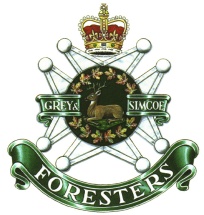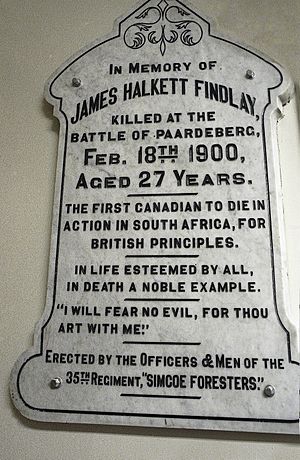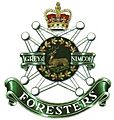The Grey and Simcoe Foresters facts for kids
Quick facts for kids The Grey and Simcoe Foresters |
|
|---|---|

Cap Badge of the Grey & Simcoe Foresters
|
|
| Active | 1866–present |
| Country | |
| Branch | Canadian Army |
| Type | Line infantry |
| Role | Light infantry |
| Size | One battalion |
| Part of | 31 Canadian Brigade Group |
| Garrison/HQ | Barrie and Owen Sound, Ontario |
| Patron | Anne, Princess Royal Colonel-in-chief |
| Motto(s) | Tenacious and Versatile |
| March | "The 31st Greys" |
| Commanders | |
| Commanding Officer | LCol D.E. Meehan CD |
| Regimental Sergeant Major | CWO D.B. Henley CD |
The Grey and Simcoe Foresters is a special group of soldiers in the Canadian Army. They are part of Canada's Primary Reserve, which means they are trained soldiers who can be called upon when needed. This group is unique because it's the only military unit in the Commonwealth of Nations (countries that used to be part of the British Empire) still called "Foresters." They are part of the 4th Canadian Division's 31 Canadian Brigade Group.
Contents
What are Foresters?
Many army groups are called "fusiliers" or "grenadiers." But only one is called "Foresters"—the Grey and Simcoe Foresters in Canada. This name comes from a very old type of soldier. Think of Robin Hood and his men in Sherwood Forest!
The Grey and Simcoe Foresters were formed in 1936. This happened when two older groups joined together: the 31st Grey Regiment and the 35th Simcoe Foresters. Both of these groups started way back on September 14, 1866.
The name "Foresters" for the Simcoe County militia goes back even further. In 1838, after the 1837 Rebellion, a special group of soldiers from Simcoe County was called the 1st Simcoe Incorporated Militia (Royal Foresters).
A Look at Their History
From Early Days to World War I
The 31st Grey Battalion of Infantry started on September 14, 1866. It was made up of six smaller companies from towns like Owen Sound and Meaford. Lieutenant-Colonel W.D. Pollard was their first leader.
At the same time, the 35th Battalion of Infantry (Simcoe Foresters) was also formed. This group included companies from Barrie and Collingwood. Lieutenant-Colonel A.R. Stephen led this new battalion.
Before these groups officially formed, they helped protect the Canada-USA border. This was during the Fenian Raids between 1864 and 1866.
In 1885, the 35th Simcoe Foresters helped form the York-Simcoe Battalion. This group went to western Canada to help stop the Riel Rebellion. Because of this, the 35th Simcoe Foresters earned their first special award, called a "battle honour," for "North West Canada 1885."
During the Second Boer War, soldiers from these groups joined Canadian forces. They went to help the British Army. Private James Halkett Findlay, from the 35th Simcoe Foresters, was one of the first Canadians to die in action. This happened on February 18, 1900, during the Battle of Paardeberg.
When World War I started, the 31st and 35th regiments helped recruit many soldiers. They formed four new battalions and sent soldiers to two others.
The Great War also led to the creation of Camp Borden. In May 1916, soldiers from the 157th Simcoe Foresters started building this new camp. It was designed to train many infantry battalions. One soldier from the 157th Simcoe Foresters, Leslie Frost, later became the Premier of Ontario.
In 1917, Private Thomas William Holmes of the 147th Grey Battalion became Canada's youngest winner of the Victoria Cross. This is a very brave award. By the end of the war, Grey and Simcoe counties had sent over 6,000 soldiers. Hundreds of them died in action.
World War II Service
During World War II, the 1st Battalion of the Foresters was called into action on June 1, 1940. They went to Camp Borden. Lieutenant-Colonel T.J. Rutherford led them.
In 1942, the 1st Battalion changed roles. They became the 26th Army Tank Battalion, part of the Royal Canadian Armoured Corps. They went to England in 1943. Sadly, the regiment was later broken up to provide soldiers for other tank groups. This meant Foresters fought in many different places during the war.
After the Wars
After World War II, the 2nd Battalion changed again. In 1946, they became an artillery unit. They were called the 45th Anti-Tank Regiment.
In 1958, the Foresters returned to their armoured role. They were known as the 28th Armoured Regiment.
Finally, in 1970, the regiment went back to its original role as infantry. They have helped people at home during many emergencies. This includes Hurricane Hazel in 1954 and the Ontario Ice Storm in 1998. They also helped with forest fires and the 1997 Red River flood.
Many members of the Foresters have also served overseas. They have been part of peacekeeping missions in places like the Middle East, Cyprus, and the Former Yugoslavia. More recently, they served in Afghanistan and Sierra Leone.
The Grey and Simcoe Foresters are located near the 4th Canadian Division Training Centre. This center trains about 10,000 reserve soldiers in Ontario. It also hosts military units from other countries for training.
War in Afghanistan
Between 2002 and 2014, more than 20% of the regiment's soldiers served in Afghanistan. They were part of different special groups there.
Battle Honours
Battle honours are special awards given to military units for their bravery and service in battles or campaigns. The Grey and Simcoe Foresters have many of these honours. Some are written on their regimental flag, called the "colour."
North West Rebellion
The Great War
War in Afghanistan
- Afghanistan
Where They Are Stationed
The Grey and Simcoe Foresters have two main locations, called armouries.
- Barrie Armoury: This building was built in 1913-14. It's a large, strong building with towers. It houses platoons (small groups of soldiers) from "B" Company.
- Tommy Holmes VC Memorial Armoury: This armoury is in Owen Sound. It houses platoons from "A" Company. It's named after Private Thomas William Holmes, who won the Victoria Cross.
Regimental Colours
"Colours" are special flags that represent a military regiment. They are very important and have a lot of history.
On May 20, 2016, the Governor General of Canada, David Johnston, gave new colours to the regiment. The old colours were placed in St. George's Anglican Church in Owen Sound in 2017.
The previous colours were given to the regiment in 1978. Before that, the regiment didn't have colours for a while. This was because they changed their role from infantry to artillery and then to armoured units.
The very first colour of the 31st Grey Battalion was presented in 1867. It was originally made for the Leith Rifles.
Other battalions also received colours. The 147th Grey (Overseas) Battalion received its colours in 1916 at Camp Borden. These were kept safe in England during the war and later returned to Canada.
The 35th Simcoe Foresters received their first colours in 1868, just after Canada became a country. Their second set of colours was presented in 1909. These were later moved to a church in Collingwood. In 2000, these 1909 colours were brought back to the regimental museum in Barrie.
The 157th Overseas Battalion (Simcoe Foresters) received its colours in 1916 at Camp Borden. After World War I, these colours were placed in St. Andrews Presbyterian Church in Barrie. They were later moved to the Simcoe County Museum and then to the regiment's Barrie Officers' Mess.
Famous Foresters
Many notable people have served with the Grey and Simcoe Foresters or their earlier groups:
- Major-General Sir Sam Steele: A famous police officer and soldier.
- Captain the Honourable Leslie Frost: He became the Premier of Ontario.
- Private Thomas William Holmes: He won the Victoria Cross for his bravery.
- Brigadier Thomas Rutherford: A high-ranking officer.
- Flight Lieutenant Alfred B. Thompson: The first Canadian to become a prisoner of war in World War II. He was also part of the famous "Great Escape."
The Grey and Simcoe Foresters Regimental Museum
| Location | Mulcaster Street, Barrie, Ontario Canada |
|---|---|
| Type | Regimental museum |
The Grey and Simcoe Foresters Regimental Museum is in Barrie, Ontario. Its goal is to keep the history of the regiment alive. It helps new soldiers feel proud of their group and their country. It also helps the public understand the military's role in the area.
The museum has many old items from the 1800s and both World Wars. Most of these items were given by members of the regiment. Volunteers from the Grey and Simcoe Foresters run the museum.
Their Badge
The badge of The Grey and Simcoe Foresters is a special symbol. It has a white Maltese Cross with a green apple in the middle. On the apple, there's a deer resting on a hill. Around this, there's a wreath of autumn maple leaves. The words "GREY & SIMCOE FORESTERS" are written on green scrolls. A crown sits on top of the badge.
This badge was adopted in 1936 when the two regiments joined. It's based on the badge of an older British regiment, the Sherwood Foresters. The regiment's flag is green and red, with the badge in silver and gold.
Alliances
Images for kids




